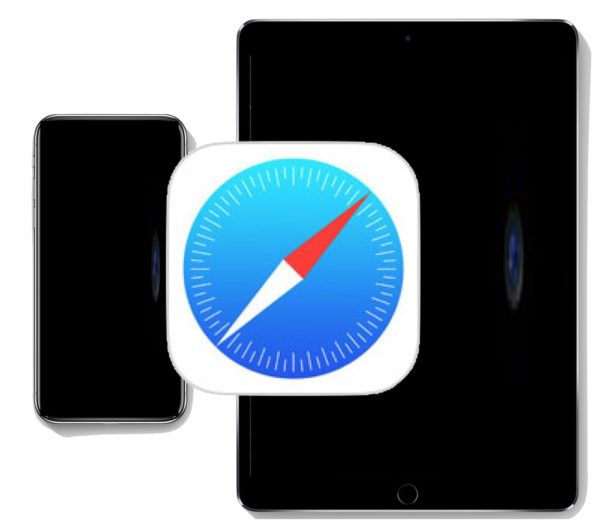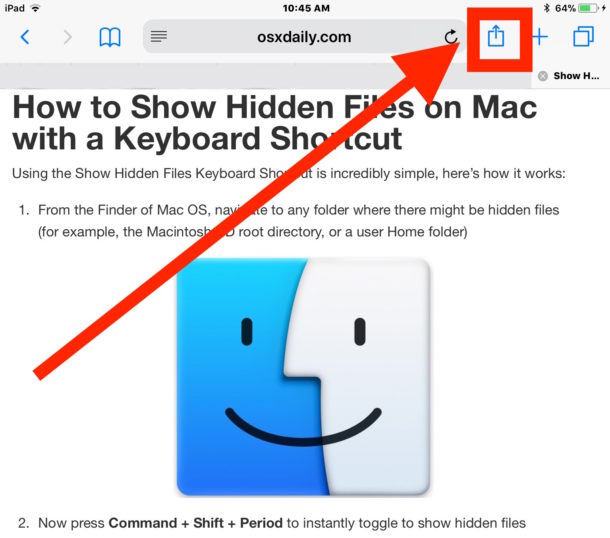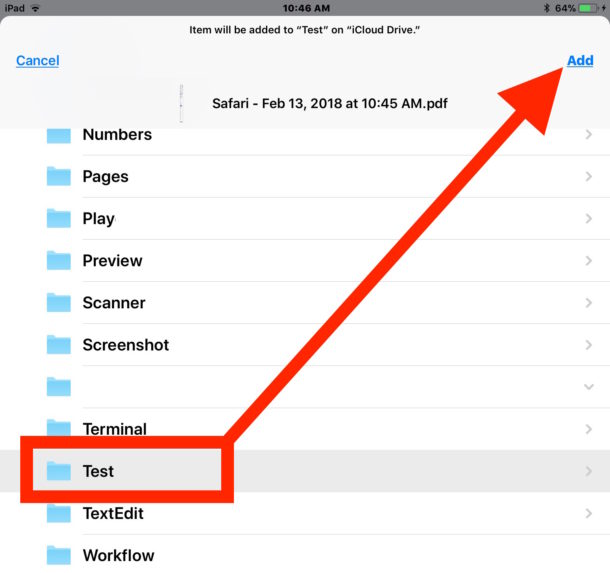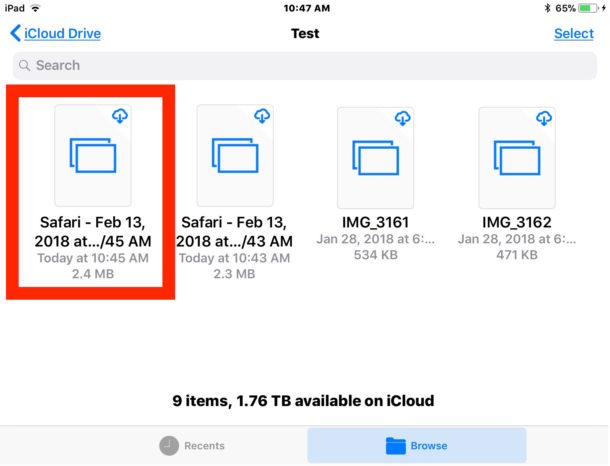How to Save a Webpage as PDF on iPad and iPhone the Easy Way

Want to save a web page as a PDF on iPad or iPhone? Generating PDF files of webpages and web articles is now easier than ever before in iOS, thanks to a new obvious “Create PDF” feature that is available in modern system software releases.
Any iPhone or iPad running iOS 11 or later now has the capability of creating a PDF file from any webpage in Safari through a direct feature; that means there is no more guesswork with hidden Save As PDF iOS gestures, or printing PDF 3D Touching, or forced use of iBooks (though those tricks still work if you prefer the secret approach), instead you can just directly initiate PDF creation with a simple method we will detail here in this tutorial.
This offers by far the fastest and easiest way to turn any web article or webpage into a PDF file on iOS.
How to Save Webpage as PDF on iPad and iPhone
This ‘Create PDF’ feature requires iOS 11 or newer. The walkthrough below demonstrates this capability on iPad but the feature is identical on iPhone as well.
- Open Safari on the iPad or iPhone
- Visit the webpage you want to save as a PDF (for example, this webpage you’re reading right now)
- Tap on the Sharing button, it looks like a box with an arrow flying out of it
- From the Sharing options, scroll through to find “Create PDF” and tap on that
- You’ll be brought to a new screen with the PDF file visible, tap on “Done” *
- Choose “Save File To…”
- From the Files app iCloud Drive browser, tap the location or Folder you want to save the webpage PDF to and then tap on “Done” to save the PDF
![]()





A PDF file of the active webpage has now been created and saved to the Files app on the iPad or iPhone.
You can confirm the webpage PDF was created and saved properly by going to the “Files” app in iOS and then choosing the iCloud Drive folder or location you chose to save the PDF to.

* Before tapping on Done, you can also tap the little marker and use Markup to draw, doodle, or write on the PDF file if desired.
By default the name of generated PDF files from Safari will be in the format of “Safari – (Date of Creation) – (Time of Creation).pdf” but you can always rename it in the iOS Files app to be something more descriptive if desired.
Because Files app is also iCloud Drive, you can access the saved webpage PDF from any other iOS device or Mac that uses the same Apple ID via the Files app in iOS or via iCloud Drive on a Mac.
Oh and here’s a bonus quick tip that can help any created PDF files from Safari look a bit better: if a webpage saved as PDF is a little too cluttered, or you just want to remove any extra styling, you can use the use the Reader trick for printing webpages and articles without ads from iOS Safari and then use the Create PDF method once Reader mode has been activated on the article in question. The Reader view strips out just about all styling on a webpage and just leaves the text and images remaining, which can make for a simpler looking PDF file as well.
As mentioned before, you’ll need one of the most modern iOS releases to have access to Create PDF feature in the Safari Sharing function. You can either update to iOS 11 or later to gain this PDF creation capability, or rely on a different method of saving webpages as PDF files. Four alternative options for generating PDF documents of webpages include:
- Using a hidden “Save As PDF” gesture in iOS 10 (or later)
- Using a hidden 3D Touch trick to create a PDF file from the Print dialog in iOS (also iOS 10 or later)
- Saving webpages into iBooks for iOS as as PDF files
- Using a Javascript bookmarklet to generate PDF documents (works in iOS 6 and later)
Each of those methods offers the same end result of a PDF file generated from a webpage, but with the new direct “Create PDF” option available in Safari for modern iOS it is hard to want to recommend any other choice unless your iPhone or iPad is on an older system software release.
Do you know of any other handy tips, tricks, or techniques for generating PDF files from webpages on an iPad or iPhone? Share them with us in the comments!


When you demonstrate a “how-to,” consider using a webpage other than one that contains instructions for another iOS technique .” It gets confusing.
On OS X the sharing icon is at the bottom of the screen
I learned another way to save web pages to PDF…from one of your columns! In the Sharing button window, choose the PRINT option, make an arcane swipe open gesture with thumb and forefinger, then save. The advantage is that uses the name of the web page as the name of the PDF. Still my fave way to do it.
Yeah they did make a mention of that method near the end of this article too (which can also work using 3D touch instead of the zoom in gesture on an iphone 6s or later).
Another advantage of that method is that it is available from ANY app that supports printing (including many if not all 3rd party browsers), whereas the create pdf button is only available from Safari.
Kate, this is useful. Thank you. But I do not think so have to save a webpage to PDF on iPhone ever… This feature is pointless for me.
I think it’s more suitable for ipad users, who tend to work more with files and documents.
Yes, you are right. iPad.
I am still working with MacBook Pro and iPhone; I was a bit insular.
“Each of those methods offers the same end result of a PDF file generated from a webpage, but with the new direct “Create PDF” option available in Safari for modern iOS it is hard to want to recommend any other choice unless your iPhone or iPad is on an older system software release.”
I happen to disagree with that statement. I think the hidden gesture/3D touch trick is really the one that makes any other choice hard to recommend for creating a pdf file. The javascript method is for older iOS versions and the create pdf button, introduced with iOS 11, is only available in Safari. The hidden gesture or 3D touch trick, on the other hand, is available from ANY app that supports printing. This includes 3rd party browsers and many other apps.
Also, the create pdf button often does a poor job in converting a web page into a multiple page document, as opposed to the 3D touch / hidden gesture trick.
In answer to BPrice and Don Wood, anything in iCloud is in Files and if you tap on the file to view it, it’s now on your device. I just verified this by turning off Wi-Fi and cellular and I can still view the files, so they are certainly on my device as well as iCloud. You could also open the file in iBooks, Notes or a third party app like GoodReader. Is this what you meant?
I think they meant to ask if there is a way to store files in the ‘on my ipad/iphone’ location within the new ios 11 files app, so that the files are stored on the device but without being uploaded to icloud too.
And as far as I know that’s only possible if you have any apps that support storing in that location and have already created their own folders in it. Examples of such apps are Adobe Acrobat, Garage Band, Nook and the iWorks suite apps (pages, numbers and keynote).
I’ve been using this method for awhile and it works well. One thing to note is that the resulting pdf file is one (often long) page, unlike the other methods which break the pdf into normal pages. Another more serious issue is that often the resulting file is truncated. The end of the original web page is cut off. I haven’t figured out yet if there is a maximum length or what.
Right. And the first two methods, which are really one and the same except for the alternative of accessing via 3D touch or pinching to zoom depending on the device used, are available from ANY app -built in or 3rd party- that supports printing. This includes 3rd party browsers such as Chrome, Firefox, etc. The ‘create pdf’ button, on the other hand, is only available in the built in Safari browser.
I have the same question.
See my response to Bprice above. Hope it answers your question.
Tangentially, is there a way to store .pdf to Files on my iOS device? Apple wants me to use iCloud, but I’d rather have them on my device.
You can store files in the ‘on my ipad’ or ‘on my iphone’ location within the new ios 11 files app -if that’s what you meant to ask about- only if you have any apps installed that support storing there and have already created their own folders. Examples of such apps are Garage Band, Adobe Acrobat, Nook, and the iworks suite apps (pages, numbers and keynote).
Incidentally, if you are working with pdf files you may want to download the aforementioned Adobe Acrobat.
Not quite. Yes, there is a Files location named On My iMac, but it only allows creation of folders from other apps. There seems to be no way of storing a .pdf there without a folder. At that level, there’s no creation of folders not associated with an app.
Right, exactly. That’s how the ‘On my [device]’ location in the files app works on iOS devices too. But once those apps have automatically created their own folders, you can store in those folders from anywhere in iOS such as in Safari via the ‘save to files’ button in the share sheet.
And I forgot to mention this, but while you cannot create folders at root level in the ‘on my [device]’ location, you can certainly create subfolders within any of the app folders.